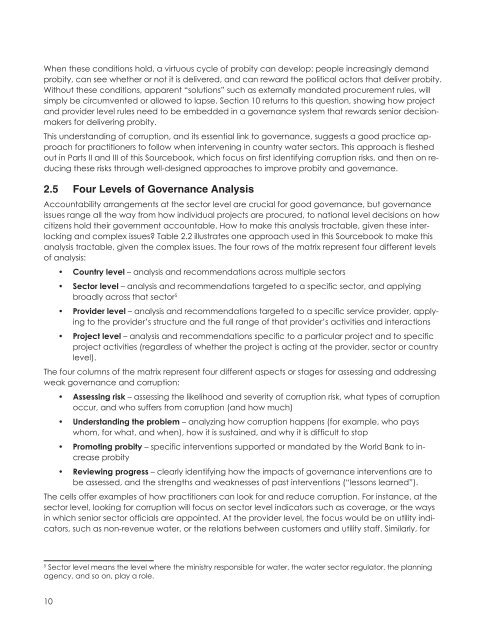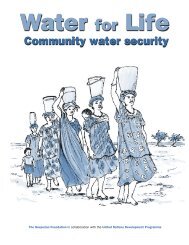A Sourcebook - UN-Water
A Sourcebook - UN-Water
A Sourcebook - UN-Water
Create successful ePaper yourself
Turn your PDF publications into a flip-book with our unique Google optimized e-Paper software.
When these conditions hold, a virtuous cycle of probity can develop: people increasingly demand<br />
probity, can see whether or not it is delivered, and can reward the political actors that deliver probity.<br />
Without these conditions, apparent “solutions” such as externally mandated procurement rules, will<br />
simply be circumvented or allowed to lapse. Section 10 returns to this question, showing how project<br />
and provider level rules need to be embedded in a governance system that rewards senior decisionmakers<br />
for delivering probity.<br />
This understanding of corruption, and its essential link to governance, suggests a good practice approach<br />
for practitioners to follow when intervening in country water sectors. This approach is fleshed<br />
out in Parts II and III of this <strong>Sourcebook</strong>, which focus on first identifying corruption risks, and then on reducing<br />
these risks through well-designed approaches to improve probity and governance.<br />
2.5 Four Levels of Governance Analysis<br />
Accountability arrangements at the sector level are crucial for good governance, but governance<br />
issues range all the way from how individual projects are procured, to national level decisions on how<br />
citizens hold their government accountable. How to make this analysis tractable, given these interlocking<br />
and complex issues? Table 2.2 illustrates one approach used in this <strong>Sourcebook</strong> to make this<br />
analysis tractable, given the complex issues. The four rows of the matrix represent four different levels<br />
of analysis:<br />
• Country level – analysis and recommendations across multiple sectors<br />
• Sector level – analysis and recommendations targeted to a specific sector, and applying<br />
broadly across that sector 5<br />
• P rovider level – analysis and recommendations targeted to a specific service provider, applying<br />
to the provider’s structure and the full range of that provider’s activities and interactions<br />
• P roject level – analysis and recommendations specific to a particular project and to specific<br />
project activities (regardless of whether the project is acting at the provider, sector or country<br />
level).<br />
The four columns of the matrix represent four different aspects or stages for assessing and addressing<br />
weak governance and corruption:<br />
• A ssessing risk – assessing the likelihood and severity of corruption risk, what types of corruption<br />
occur, and who suffers from corruption (and how much)<br />
• U nderstanding the problem – analyzing how corruption happens (for example, who pays<br />
whom, for what, and when), how it is sustained, and why it is difficult to stop<br />
• P romoting probity – specific interventions supported or mandated by the World Bank to increase<br />
probity<br />
• R eviewing progress – clearly identifying how the impacts of governance interventions are to<br />
be assessed, and the strengths and weaknesses of past interventions (“lessons learned”).<br />
The cells offer examples of how practitioners can look for and reduce corruption. For instance, at the<br />
sector level, looking for corruption will focus on sector level indicators such as coverage, or the ways<br />
in which senior sector officials are appointed. At the provider level, the focus would be on utility indicators,<br />
such as non-revenue water, or the relations between customers and utility staff. Similarly, for<br />
5<br />
Sector level means the level where the ministry responsible for water, the water sector regulator, the planning<br />
agency, and so on, play a role.<br />
10
















